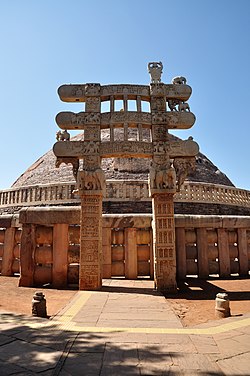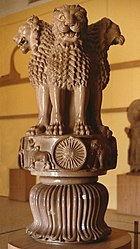Sanchi Stupa and Lion Capital are significant parts of ancient history. It represents the art of the Mauryan Dynasty. The Maurya Empire ruled over India from 322 to 185 BCE, during which period Indian art and architecture saw significant changes. In this article, we will study one of the finest examples of Mauryan sculpture, the Sanchi Stupa and Lion Capital.
Great Stupa of Sanchi
Sanchi Stupa has been a UNESCO World Heritage Site since 1889. The stupa is located in Sanchi, Madhya Pradesh. The great emperor Ashoka built the Great Stupa of Sanchi in the 3rd century BCE, and it is one of India’s oldest stone structures as well as an important Buddhist architectural monument.

Great Stupa of Sanchi: Historical Significance
- As built by the Great Ruler of India Ashoka, it is believed to be the relics of Buddha.
- This structure underwent restoration during the Shunga and Satavahana eras. The Shungas built the balcony and stairway, while the Satavahanas built the gateways.
Great Stupa of Sanchi:Architecture
- The primary building is a large hemispherical dome. It stands 54 feet high and 120 feet wide.
- The harmika, or little square railing, is located at the top of the dome.
- A chhatra crowns the harmika, symbolising Buddhism’s Three Jewels: the Buddha, the Dharma (teachings), and the Sangha (community).
- There are four carved gateways at the cardinal points of the entrance that reflect Buddhist and Jataka tales.
Great Stupa of Sanchi:Cultural Significance
- Over the years, Sanchi Stupa has been known as a popular pilgrimage place for Buddhists. It served as the learning centre for Buddhist culture.
- The Sanchi Stupa was named a UNESCO World Heritage Site in 1989 for its historical, architectural, and cultural significance.
Great Stupa of Sanchi:Preservation
- A British officer discovered the location in the early 19th century. Recent studies and restoration initiatives have helped to maintain and conserve the stupa and its surrounding structures.
The Sanchi Stupa is evidence of India’s rich culture and legacy, which continues to attract people from all over the world.
Also Read: Arts of the Mauryan Period | UPSC Art & Culture Notes
Sarnath Lion Capital
The Lion Capital of Sarnath is an important symbol of Indian history and culture. This architecture was built by the Mauryan ruler Ashoka. Its features include four life-size lions placed on a drum-shaped abacus.

Sarnath Lion Capital:Historical Significance
- Emperor Ashoka constructed the Lion Capital in 250 BCE. This pillar was built by Ashoka after his conversion to Buddhism.
- This is to mark the Buddha’s first sermon at Sarnath, near Varanasi in Uttar Pradesh. His sermon, known as the Dhammacakkappavattana Sutta, taught the Four Noble Truths and the Eightfold Path, which constitute the basis of Buddhist teachings.
Sarnath Lion Capital:Architectural Feature
- The Lion Capital is made up of polished sandstone.
- The structure is made up of four lions standing back to back on top of a circular abacus. The four lions symbolise power, courage, confidence, and pride. The circular abacus has carvings of a bull, horse, elephant, and lion, representing various stages of Buddha’s life and teachings. The abacus rests on a bell-shaped lotus, which represents purity and enlightenment.
Sarnath Lion Capital:Cultural Importance
- The Lion Capital was adopted as India’s national emblem on January 26, 1950, the day the country became a republic.
- The Dharma Wheel, also known as the Ashoka Chakra in the abacus, can be seen in the centre of the national flag. The chakra has 24 spokes, which represent the 24 virtues of life and the motion of time.
Sarnath Lion Capital:Preservation
- The original Lion Capital is preserved in the Sarnath Museum, which is located near the archaeological site where it was found. This museum preserves and exhibits numerous objects from the ancient site of Sarnath.
Sarnath Lion Capital:Symbolism
- Dharma and Buddhism are fundamental to this Mauryan architecture. The lion represents the spread of Dharma, while several other animals, like bull, elephant and horse represent the various stages of Buddha’s life.
- This shows Buddhism’s immense impact on Indian culture and history.
The Lion Capital at Sarnath is a wonderful symbol of rich Indian culture and heritage. It teaches the importance of peace, tolerance, and righteousness, which are encouraged by the Buddhist religion.
FAQs
Where is the Lion capital kept now?
The Lion Capital of Ashoka was found at Sarnath, near Varanasi in Uttar Pradesh, India. The original Lion Capital is preserved in the Sarnath Museum, which is located near the archaeological site where it was found. This museum preserves and exhibits numerous objects from the ancient site of Sarnath.
There are numerous small stupas with three main ones: Stupa 1, Stupa 2 and Stupa 3. Stupa 1 is the largest and oldest stupa at the Sanchi. Stupa 2 is known for its beautifully carved railings while Stupa 3 contains relics of the Buddha’s two main disciples, Sariputta and Mahamoggallana.
Sanchi has several ancient names, such as Kaknam, Kakanaya, Kakanava, Kakanadabota, and Bota-Sriparvata. The place is well-known for its outstanding examples of Buddhist art and architecture from the Maurya period.
Related Posts
| Chalukya Dynasty | The Mauryan Empire |
| Ashoka: The Great Ruler of the Mauryan Empire | Who Is The Founder of Buddhism? |
| Who was Bindusara? | Lodi Dynasty |
| Gupta Empire: Rise, Rulers, UPSC Notes | Buddhist Education System |
This was all about the “Sarnath Lion Capital & Great Stupa of Sanchi”. For more such informative blogs, check out our UPSCExams Section and Study Material Section, or you can learn more about us by visiting our Indian exams page.
 One app for all your study abroad needs
One app for all your study abroad needs














